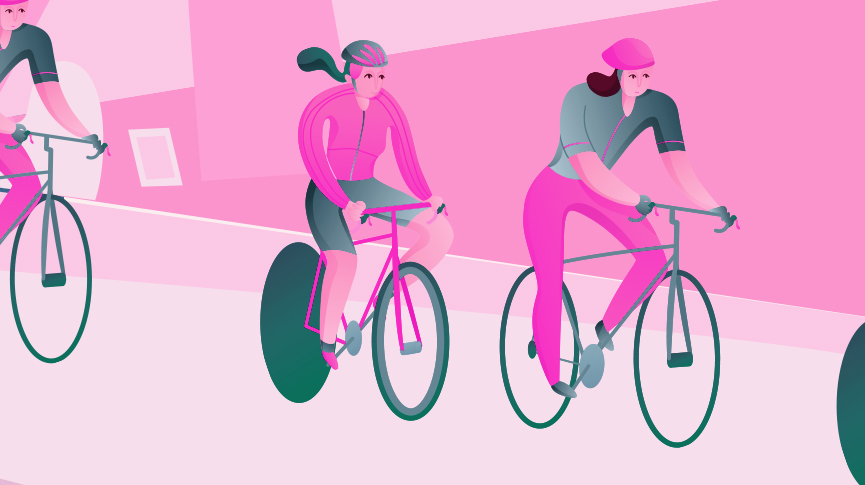Playing Sports on Your Period: What Athletes Need to Know

If you’re an athlete, chances are you’ve had your period coincide with a big game or competition. And for many, that has caused groans and annoyance. In fact, by age 14, people who menstruate are dropping out of sports at twice the rate of their peers, which is partially impacted by factors related to their periods. But there’s research suggesting that if athletes know about their body, it can help their performance when it comes to playing sports on your period.
Formerly, much athletic training research has focused on cis men as subjects. However, people with a menstrual cycle are not simply smaller versions of athletes who don’t menstruate. Our hormones are complex and impact our athletic performance. But it would be a mistake to assume it puts us at a disadvantage. In fact, learning your cycle inside and out can actually help you as a high-performance athlete. Here’s why.
Playing Sports on Your Period
Things like cramps or worries about leaking are all reasons why your life as an athlete can be impacted by your period. But puberty might start affecting young athletes before their start their first periods.
Many body changes start happening around age eight. And while puberty in non-menstruators means getting leaner and stronger, that isn’t the case in people who will get a period. The early stages of puberty signal a radical change in body shape. Your hips get wider, you gain weight, and your center of gravity shifts. Many people start to feel clumsy in their bodies, and that can make them feel like they just aren’t as fast or as good as they once were.
Because the effect of these changes on athletic performance isn’t really discussed, it can be discouraging to a lot of young athletes. But being aware of these changes can help you feel less alone. In fact, it can even make you realize which new advantages your body has! As discussed on the Curious Climbers podcast with Dr. Sims (whose work we will be talking about in this article), the host Mina explains how her post-puberty body actually helps her as a rock climber. She explains that research has found that having wider hip angles and being able to open your hips more helps you get closer to the wall, which means you’re able to take on much harder climbs with comparatively lower finger strength!
But even if you’re not a rock climber, understanding your cycle can help you unlock better achievement as an athlete—if you understand it.
Let’s Recap on the Menstrual Cycle
Before you get too excited about your period as the perfect performance-enhancing aid, let’s just take a minute to re-familiarize ourselves with the menstrual cycle. It’s a complex combination of hormones at work here!
The ‘standard’ period is 28 days. Ish. Not everyone has a 28-day cycle, and not every month’s period is the same. We’ll talk about a 28-day cycle here for the sake of simplicity, and about how you can figure out your cycle length and apply these to your training.
Day 1-14:The Follicular Phase
Day 1 is counted as the first day of bleeding. It’s the start of the ‘follicular’ phase, and during it, the hormones estrogen and progesterone are quite low.
Day 14: Ovulation
Ovulation is when an egg is released from your fallopian tubes. During ovulation, more estrogen and luteinizing (LH) hormones are secreted.
Day 15-28: Luteal Phase
Early Luteal Phase: Right after ovulation, there is a drop in LH until next month’s cycle. Estrogen has a sudden drop but then starts to come up again after the surge. Progesterone levels also start to increase again, which causes the gradual thickening of the endometrial lining in preparation for your next period.
Late Luteal Phase: This when most people experience their worst PMS symptoms. Right before your period starts, estrogen and progesterone will drop to their lowest level, while the follicle-stimulating hormones will start to get ready for the next phase.
What Do These Phases Have to Do With My Performance As an Athlete?
In athletes, our menstrual cycles can vary a lot. But by tracking your natural cycle (not impacted by the combination pill) you can learn a lot.
For instance, high stress and not taking care of our bodies can shorten our cycle. Think about more relaxed times in your training schedule. When you’re getting better sleep, not stressed out about a big competition or not traveling, your athletic recovery time is better. You might also notice that your cycle is longer, and you can treat that as your ‘best case’ or baseline cycle length. (It’s important to note, during this time it’s your follicular phase that’s getting longer, not the luteal phase, which stays pretty constant.
But if you look at endurance athletes or someone who is overtraining, they may experience a shortened luteal phase or a luteal defect. This leads to an overall shorter cycle compared to their average. If you notice this, you can get checked for progesterone insufficiency and anovulation. You can also start looking at your lifestyle and ask questions like, “Am I training too hard?’ ‘Am I eating enough?’ or ‘Am I getting enough sleep?’
In fact, we’re luckier than non-menstruators in this way, because we have this subtle insight into the effect our training is having on us!
How Should I Work Out Differently During My Cycle?
Dr. Sims has been studying the effect our cycles have on athletes, and has some advice on how to best train to take advantage of your hormone fluctuations. Note that these recommendations are all general; it’s about what works for you. If you struggle with strong PMS—or the more debilitating PMDD—then you shouldn’t be pushing yourself to train during these times if it doesn’t feel right
Day 1-14:The Follicular Phase
Generally, the follicular phase is when it’s time to push yourself. If you’re trying to make big gains (either in strength or aerobic training) this is when you should push yourself to the 80-90% threshold of exhaustion. This is your top end of training, so think HIIT or doing high weight, low rep strength training.
Day 14: Ovulation
Dr. Sims suggests that at ovulation, some people feel amazing some people feel a bit
“flat.” It all depends on how sensitive you are to that surge in estrogen. If you don’t get that flat feeling, or feel like you can push through, this is still a time where you can (safely) hit your training a bit harder., right after this surge. That’s because you’ll have an anabolic stimulus from the residual estrogen.
However, do be cautious. That estrogen surge has an effect on our tendons, which may be why menstruating athletes have higher rates of ACL injuries.
Day 15-28: Luteal Phase
Early Luteal Phase: This is when you can trade in your high-intensity interval workouts for more ‘steady state’ workouts. A steady state workout means maintaining a consistent speed, level of intensity, and work rate during a training session.
Late Luteal Phase: Five to seven days before your period (usually your PMS week) is when you can ‘deload.’ That means reducing the weight you’re lifting and the intensity of your aerobic workouts.
But that doesn’t mean a week off of training! Dr. Sims believes this is the perfect time to focus on your technique and other skills like cognition, balance, and reactions. The reasoning is, your body is overall ‘tired’ regardless of what you’re doing externally. Making your body practice these ‘micro skills’ when you’re in a lower performance state means that you’ll be able to call onto that technique when you’re ‘up’ again.
Conclusion
Part of becoming a high-performance athlete is learning to make your body perform at high efficiency, so it works smarter rather than harder at game time. And knowing how your cycle affects your training is an important step for that. There are plenty of amazing athletes who menstruate, though a lot of them have had to make it work despite training theory that is based on non-menstruators. Luckily, this is all changing, so we will see more and more athletes using cycle knowledge to reach their peak!
Want to Help Other Athletes Stay in the Game?
There are plenty of factors that impact people’s ability to participate in sports, but periods or reproductive illness shouldn’t be one of them. That’s why we’re working with A.P.E. Onlus. For 11 years, A.P.E. Onlus has been composed of volunteer women in Italy affected by endometriosis. They’ve turned their personal experience into tangible support for other people through awareness and support.
Right now, for every menstrual cup bought in Italy, we will donate one to A.P.E. Onlus so they can give it to someone in need. Show someone you can by putting a menstrual cup in your cart today!

Lane Baumeister is an internationally-based Canadian writer with several years’ experience creating educational and entertaining articles that discuss intimate health and sexual well-being. When not waxing profound about menstruation, she devotes herself to enjoying extremely good food and equally bad movies.


